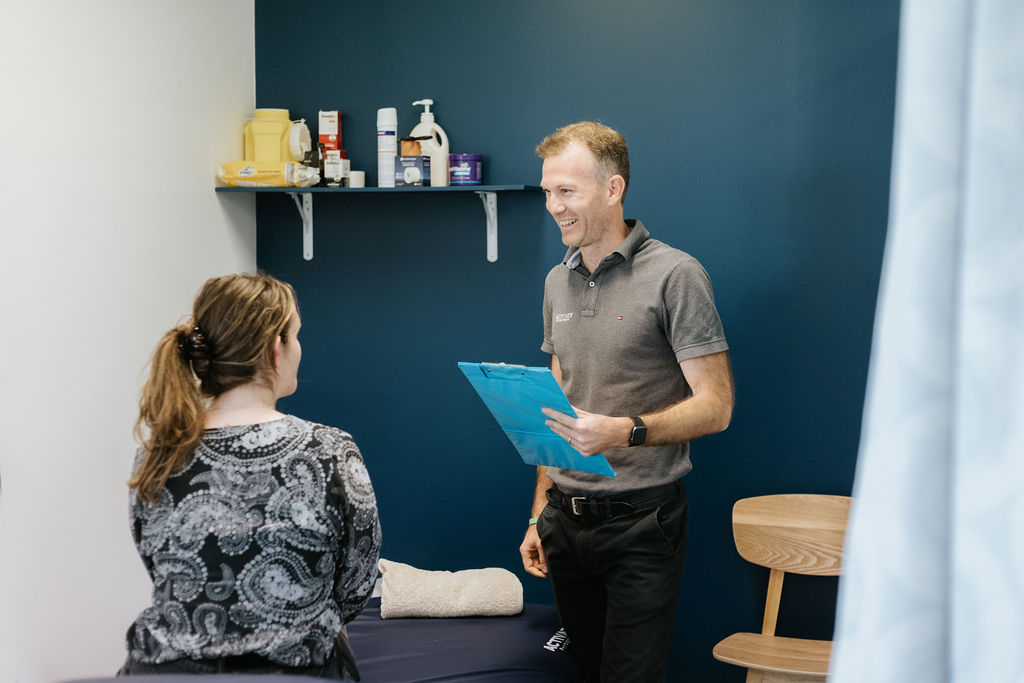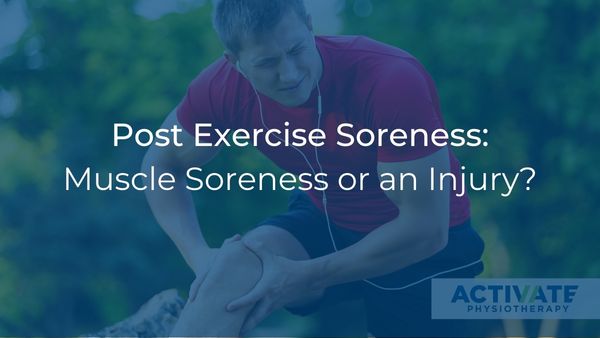If you’ve gotten back into activity as a new year’s resolution or maybe just getting back into the routine after a Christmas break you might have experienced some aches and sore muscles as a consequence. And trust us… we know it can be painful! So how do you know whether it is just muscle soreness or if its something to be worried about?

The most common cause of muscle soreness is called delayed onset muscle soreness, or DOMS for short. When you perform physical activity whether it is going for a walk, lifting weights or even doing a few hours of gardening, your muscles undergo mild damage. This is especially true if the activity is unfamiliar, you haven’t done it in a while or you’ve gone harder than before. Basically, the harder your muscles work, the more muscle damage. But don’t worry — this damage, typically, isn’t a bad thing. In fact, it’s part of the muscle-building process and it’s how they are stimulated to become stronger.
Ok, but I’m really sore. Like it hurts when I sit down on the couch sore!
We know, we have been there too. Whilst it’s annoying and disheartening to be so sore after trying to do the right thing and engage in physical activity, the best thing to do is move through it. Activate’s Clinical lead Physiotherapist Emily Phillips says “In the case of muscle soreness REST IS NOT BEST. The safest way to help to resolve the soreness as quickly as possible is to use the muscles, albeit a little less intensely. This should help to reduce the tenderness and stiffness.”
“The classic DOMs case might feel a lot of pain sitting or standing up from a seat, but once they take a few steps the symptoms ease up” says Emily. “Try a lighter version of the exercises to assist with alleviating any muscle soreness. Other ideas could be walking, swimming, gentle stretching, light resistance exercise or an easy jog.”
Could it be an injury?
Whilst the most common reason for pain after activity is DOM’s, It is possible that exercise at a increased intensity can cause injury.
Generally DOM’s will settle in 3-5days and whilst it can be quite painful, the discomfort is generally more difuse and difficult to pinpoint. Whilst it may feel like the muscles are bruised you’re unlikely to notice any discolouration (bruising or redness) or swelling. Instead you feel tender and tight and may feel like you can’t move your joints though their full range.
For a definitive answer the best thing to do is see a Physiotherapist who are the experts in assessment, diagnosis and treatment of musculoskeletal conditions. They will ask you a series of questions and perform tests to determine whether your pain is coming from DOMs or an injury.
Your physio may ask things like:
- What you did before the pain came on
- Did you have any pain during the activity or did it come on later
- How long has the pain been there
- Have you had the pain before
- What kinds of things are making the pain worse
- What kinds of things are making the pain better
- Does the pain get any better when you’re moving around
All of these questions help to determine whether you’re suffering from muscle soreness or an injury.

What kind of injury might it be?
Another common culprit of soreness is tendonitis, which is inflammation of a tendon. Tendonitis is a very common overuse injury that can happen anywhere in the body. Tendonitis can be acute or may be more chronic, where exercise flares up an existing injury.
Another more acute injury is a muscle strain, when your muscle fibers frey or pull apart. There are different grades or levels of severity of a muscle strain and these injuries tend to be more acute and produce symptoms at the time of injury, rather than having a delayed onset.
I’m worried this is me, what should I do?
This is where it is important to see a Physiotherapist who is an expert in analysing ALL of the factors that have led to you developing post exercise soreness.
“We find many people simply apply RICE (Rest, Ice, Compression, Elevation) therapy. However, if all you do is rest a muscle strain, it won’t actually get any better” Emily points out. “Tendonitis or a muscle strain that goes untreated will stay chronically weak and may lead to the issue becoming chronic, reoccuring and preventing the ability to perform activty in the future. When we evaluate a muscle strain, we determine where the strain is exactly, how bad it is and what you’ll need to do to heal — which generally involves a treatment regime to assist with resolving pain, regaining your flexibility, working to regain your muscle strength and returning you to activity as quickly as possible.”
The good news is that getting assessed and starting on treatment early, should enable most injuries to resolve completely with conservative treatment without the need for injections or surgical intervention. In all cases it is best to have a thorough assessment performed by a Physiotherapist and commence on treatment to resolve the underlying issues before progressing to more invasive treatments.
Can Activate Physiotherapy help with post exercise soreness or injury?
If you’re wondering if your soreness is the result of DOMs or an injury, or you’re wanting help to get out of post exercise pain we can help. Our team of Physiotherapists are trained to provide a complete assessment and treatment of musculoskeletal pain and injury. We are specialised in providing you with management to heal what hurts and empowering you to get on with living your life.
For a free 15minute phone consultation with a physio to get more advice or discuss your specific concerns click here.
Chung, Hume & Maxwell 2003, Delayed Onset Muscle Soreness. Sports Medicine.



Recent Comments